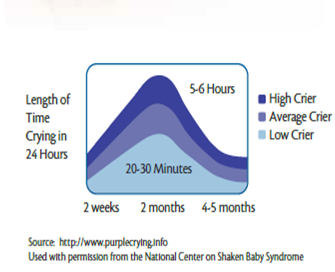Why is my baby crying? What can I do?
Updated August 28th, 2018

All babies cry. Crying is how babies tell you that they need something. Some babies cry more than others. Understanding why your baby might be crying can help you soothe your baby. Sometimes a baby cannot be comforted, no matter how hard you try. You may feel overwhelmed and it may be comforting to know that many parents have these feelings. If you soothe your baby throughout the day (not just when baby cries) it may help reduce how much and how hard your baby cries.
A crying baby…
- is not being bad
- is not angry with you
- does not mean that you are a bad parent
Most babies
- Start crying at birth
- Cry the most at about 2 months
- Start crying less at 3-5 months

Safety tip: Never shake a baby! Babies have weak necks and heavy heads. Even a few seconds of shaking can cause serious injury such as blindness, inability to walk, brain damage, or death.
Why might my baby be crying?
| If your baby is crying and… | Your baby may… | You can try… | |
|---|---|---|---|
 |
|
|
|
 |
|
|
|
 |
|
|
|
 |
|
|
|
 |
|
|
|
 |
|
|
|
| If your baby is crying and… | Your baby may…. | You can try… | |
|---|---|---|---|
 |
|
|
|
 |
|
|
|
 |
|
|
|
 |
|
|
|
 |
|
|
|
You know your baby best. If you think he or she might be sick, contact your doctor, public health nurse, or call Health Links – Info Santé anytime at (204) 788-8200 or toll-free 1-888-315-9257.
Staying calm when your baby cries
Sometimes a baby will continue to cry even though he or she is not sick, hungry or needing a diaper change. This can feel overwhelming. Staying calm is the best way to soothe your baby. When you are calm, it is easier to listen and discover what your baby needs. Remember, you’re not alone. All babies go through a crying phase. It won’t last forever.
These tips can help you relax, stay calm and cope while your baby is crying.
Take a break– Gently place your baby on his or her back in the crib and leave the room. Check on your baby every 5 to 10 minutes. Your baby will be safe and you can use the time to calm down.
Breathe slowly- Take 3-10 long, slow breaths through your nose to feel calmer.
Call a friend or family member- Ask them to come over for company or talk on the phone. Share your feelings with them.
Ask for help-If you need a break, let your partner, neighbour or family member care for your baby.
The Period of PURPLE Crying website has lots of good information on causes of crying and how to soothe your baby.